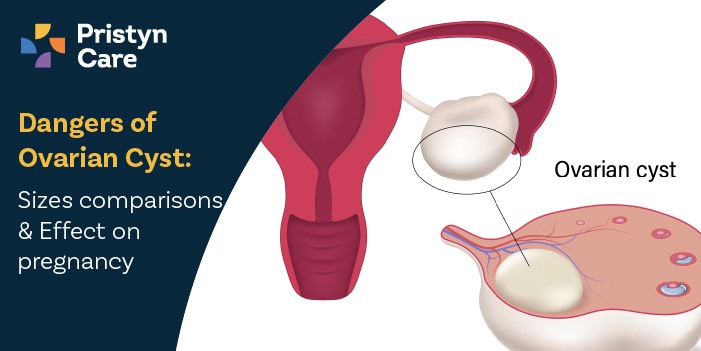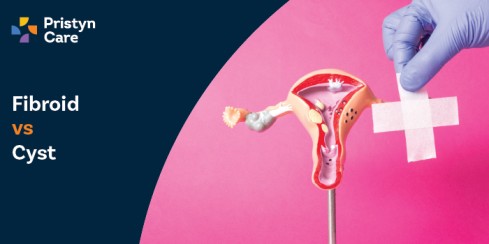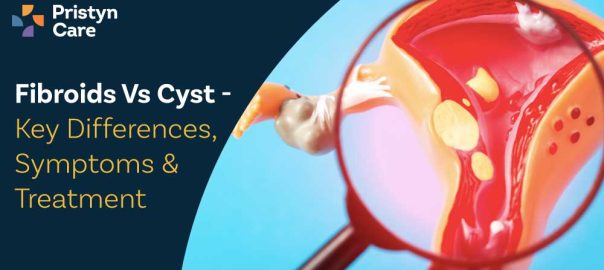![]() Views: 5
Views: 5
Dangers of Ovarian Cyst: Size Comparisons & Effect on Pregnancy
Dedicated Support at Every Step!
Our Doctors are available 24 hours a day, 7 days a week to help you!
Table of Contents
What Are Ovarian Cysts?
Ovarian cysts vary in size and type. The most common types are functional cysts, such as follicular cysts and corpus luteum cysts, which typically form during the menstrual cycle and usually disappear without intervention. Pathological cysts, like dermoid cysts, cystadenomas, and endometriomas, are more complex and may cause health issues.
Four Common Types of Cysts
Most ovarian cysts are functional cysts, formed due to hormonal changes around the menstrual cycle rather than disease. These cysts often resolve without treatment. Other common types of ovarian cysts include:
- Corpus luteum cysts
After an ovary releases an egg, the corpus luteum forms and releases hormones to support early pregnancy. Sometimes, it fills with fluid and forms a cyst. These cysts typically resolve, but can cause pain if they rupture or bleed.
- Follicular cysts
When a follicle fails to release an egg during ovulation, it can fill with fluid, forming a follicular cyst. These cysts are usually harmless and disappear within a few menstrual cycles.
- Endometriomas
These cysts develop from endometrial tissue, which normally lines the uterus but can grow on the ovary in conditions like endometriosis. Endometriomas may cause pelvic pain and affect fertility.
- Dermoid cysts
Also called teratomas, dermoid cysts contain various tissues such as hair, skin, or teeth because they develop from reproductive cells. They are usually benign but can grow large and cause complications.
No Cost EMI, Hassle-free Insurance Approval
Understanding Ovarian Cyst Sizes
When doctors talk about ovarian cyst sizes, they usually refer to the diameter measured via ultrasound. Cysts are often categorised by size:
- Under 4 cm
Cysts this small are usually harmless and tend to disappear on their own. Most women never feel symptoms, and doctors simply monitor them if anything seems unusual. - 4 to 6 cm
These cysts can cause mild discomfort or period changes, but they rarely need treatment. Doctors often choose watchful monitoring to make sure the cyst does not grow or cause problems. - Over 6 cm
Larger cysts bring a higher chance of pain, twisting of the ovary, or rupture. Because of these risks, doctors usually recommend closer follow up and may discuss treatment options. - Over 10 cm (very large)
Very large cysts can press on nearby organs and create strong discomfort or bloating. They often need surgical removal because the size increases the chance of complications or possible cancer.
The table below shows clear ovarian cyst treatment guidelines based on size and symptoms to help guide appropriate management.
| Cyst Size | Symptoms & Indicators | Treatment Recommendation |
| Under 4 cm |
|
|
| 4–6 cm | Mild discomfort or irregular periods | Close observation with ultrasounds and possibly hormonal therapy. |
| Over 6 cm | Causes pelvic pain, pressure, or bloating. | Surgical removal is recommended to prevent complications. |
| Suspected Malignancy |
|
|
Symptoms of Ovarian Cysts
Many cysts are silent, but when they do cause symptoms, women may experience:
- Dull or sharp pelvic pain on one side
- Bloating or a feeling of fullness in the abdomen
- Pain during intercourse
- Painful periods or irregular bleeding
- Sudden severe pain with nausea/vomiting (suggestive of torsion or rupture)
Ovarian Cyst Risks & Complications
Even if a cyst is not malignant, there are several ovarian cyst risks associated with large or complex cysts:
- Torsion: A cyst, especially when large, can make the ovary twist around its supporting ligaments, cutting off the blood supply. This can also cause sudden and severe pelvic pain, along with nausea, and vomiting.
- Rupture: When a cyst bursts, it can spill its fluid into the pelvic cavity, sometimes causing internal bleeding, sharp pain, or infection.
- Hemorrhage: Some cysts (like corpus luteum cysts) are more prone to internal bleeding.
- Malignancy: Not all cysts are benign. Complex cysts, especially in older women, may carry a higher risk of cancer. According to oncology resources, complex cysts have been linked with a cancer risk. Studies estimate that complex ovarian cysts have a malignancy risk ranging from about 0.4% to up to 6.6%, depending on age and features.
- Ovarian loss: In cases of torsion, large or complex cysts, there can be ovarian damage or even loss (oophorectomy) if the blood supply isn’t restored.
- Surgical risks: Surgery to remove cysts is not without risks. In pregnancy, surgery introduces risk to both mother and fetus (more on this later).
Can Ovarian Cyst Affect Pregnancy?
The answer depends on the cyst’s type and size.
- Small functional cysts, such as follicular or corpus luteum cysts, are common and usually do not interfere with conception or a healthy pregnancy.
- During pregnancy, some ovarian cysts, especially functional ones like corpus luteum cysts, naturally regress.
- Surgical removal of cysts during pregnancy (when needed) tends to be safest in the second trimester, balancing risk to the mother and fetus both.
- Minimally invasive surgery (laparoscopy) can be used during pregnancy under certain conditions because the risk of removing ovarian cyst during pregnancy increases.
- Reasons doctors may recommend surgery in pregnancy include:
- Very large cysts (often >8–10 cm) that have a high torsion or rupture risk
- Rapidly enlarging cysts
- Strong suspicion of malignancy
- Severe symptoms not controlled with conservative measures
Can Ovarian Cyst Cause Infertility?
Another major concern is: “Can ovarian cyst cause infertility?” The relationship between cysts and fertility depends on the underlying cause:
- Functional cysts usually do not cause long-term fertility problems and often resolve on their own.
- Endometriomas (chocolate cysts caused by endometriosis) can damage normal ovarian tissue, reduce ovarian reserve, and make it harder to conceive naturally.
- Polycystic ovary syndrome (PCOS) involves multiple small follicles (often miscalled “cysts”) and can disrupt ovulation, leading to difficulty conceiving.
- Repeated surgeries on the ovaries to remove cysts, especially large endometriomas, may reduce ovarian reserve if too much healthy tissue is removed.
How Long Can Cyst Delay Period?
Functional ovarian cysts form from follicles involved in ovulation, so they can temporarily alter hormones and impact the menstrual cycle.
- A functional cyst that forms when a follicle fails to release an egg may mean ovulation did not occur that month, causing a delayed or missed period.
- In many women, a simple functional cyst might delay the period by a few days to a couple of weeks.
- In conditions like PCOS, where multiple follicles are stuck in a “cyst-like” stage, and ovulation happens infrequently, cycles may become very irregular or absent for months.
Ovarian Cysts and Long-Term Fertility Planning
For women trying to conceive in the future, careful planning around cyst management is essential:
- Small, simple cysts are usually just monitored with follow-up scans.
- If a cyst is large or complex, surgery may be recommended, but an effort is made to preserve as much healthy ovarian tissue as possible (cystectomy rather than removing the whole ovary).
- For women with endometriomas, timing of surgery and fertility treatments (like IVF) is often planned together to minimise loss of ovarian reserve.
- When complex ovarian cyst cancer risk is a concern, appropriate oncological evaluation is prioritised, and fertility-preserving options can be discussed for selected early-stage cancers.
When to See a Doctor In Case of Pregnancy
Seek prompt medical attention if you notice:
- Sudden, severe pelvic or abdominal pain, especially with nausea or vomiting
- Faintness, dizziness, or signs of internal bleeding
- Rapidly increasing abdominal size or bloating
- Persistent pelvic pain, pressure, or pain during intercourse
- Unexplained weight loss, persistent bloating, or early satiety (feeling full quickly)
- Irregular periods, trouble conceiving, or recurrent miscarriages
Ovarian Cyst Surgery Procedure
Pre-Surgical Testing
Before surgery, a series of diagnostic tests is performed to ensure the patient is fit for the procedure. Blood tests help detect anaemia or infection, while imaging, such as an ultrasound or MRI, confirms the cyst’s size, type, and exact location. Additional assessments, like an ECG or chest X-ray, evaluate heart and lung function to ensure safe administration of anaesthesia.
Pre-Operative Instructions
In the hours leading up to surgery, patients are advised to fast for 6–8 hours to reduce anaesthesia-related risks. Doctors may adjust or temporarily discontinue medications such as blood thinners or certain supplements. It is also recommended to arrange transportation in advance, as patients are not permitted to drive post-procedure due to lingering sedation effects.
Postoperative Care
After surgery, recovery typically involves adequate rest and avoiding strenuous activity for 1–2 weeks, depending on the surgical approach. Pain gradually improves with prescribed medications, and patients are encouraged to monitor for signs of complications. Follow-up visits are scheduled to assess healing progress, review pathology reports if needed, and ensure a smooth return to daily activities.
Conclusion
Ovarian cysts are common, and most are harmless—but understanding ovarian cyst sizes, symptoms, and risk factors is essential for early detection and timely treatment. Small cysts often resolve naturally, but larger or complex cysts may lead to complications like rupture, torsion, infertility issues, or—in rare cases—cancer. For women planning pregnancy or already pregnant, monitoring cyst growth plays a critical role in preventing complications. If you experience persistent pelvic pain, irregular periods, or sudden severe symptoms, consult a gynaecologist promptly to ensure safe and effective care.
FAQs
1. What size of ovarian cyst is dangerous?
Cysts over 6 cm carry higher risks of torsion, rupture, or pressure on surrounding organs. Cysts above 10 cm are considered more dangerous and often require surgical removal due to increased risk of complications or potential malignancy.
2. Can ovarian cysts affect pregnancy?
Yes, depending on the cyst type and size. Small functional cysts usually don’t affect pregnancy, but large cysts (above 8–10 cm) may increase the risk of torsion, rupture, or complications. In some cases, surgery may be recommended during the second trimester.
3. How long can a cyst delay your period?
A functional ovarian cyst can delay your period by a few days to a couple of weeks, depending on whether ovulation was affected. In conditions like PCOS, delays or missed periods can last weeks to months.
4. What is the complex ovarian cyst cancer risk?
Complex ovarian cysts may carry a malignancy risk ranging from 0.4% to 6.6%, depending on age, ultrasound features, and medical history. Suspicious cysts require timely evaluation and specialist referral.
5. What is the risk of removing an ovarian cyst during pregnancy?
Surgery during pregnancy carries a small risk of miscarriage or preterm labour. However, removing a dangerous cyst- especially one that is large, rapidly growing, or suspicious—is often safer than leaving it untreated. Surgery is generally preferred during the second trimester when possible.











